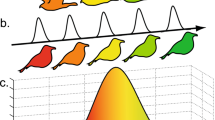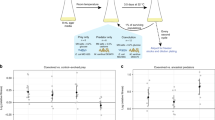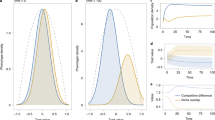Abstract
Much of life’s diversity is thought to have arisen through successive rounds of adaptive radiation—the rapid diversification of a lineage into a range of ecologically and phenotypically distinct species1,2,3. Both resource competition and predation have been suggested as mechanisms driving this process4,5, although the former is better studied than the latter6,7. Here we show experimentally how predation by a protist, Tetrahymena thermophila, affects diversification in a model adaptive radiation of the bacterial prey, Pseudomonas fluorescens. We estimate the frequency-dependent fitness functions of competing niche-specialist prey in the presence and absence of predation, and use these to test hypotheses about the extent (measured as the number of new genotypes) and rate of diversification. Competition and predation independently generated diversifying selection that we show is capable of driving prey diversification to similar extents but at different rates, diversification being markedly delayed in the presence of predators. The cause of this delay stems from weaker diversifying selection due to the reduction in prey density caused by predation. Our results suggest that predation may play an under-appreciated role in driving adaptive radiations.
This is a preview of subscription content, access via your institution
Access options
Subscribe to this journal
Receive 51 print issues and online access
$199.00 per year
only $3.90 per issue
Buy this article
- Purchase on Springer Link
- Instant access to full article PDF
Prices may be subject to local taxes which are calculated during checkout



Similar content being viewed by others
References
Simpson, G. G. The Major Features of Evolution (Columbia Univ. Press, New York, 1953)
Hedges, S. B., Parker, P. H., Sibley, C. G. & Kumar, S. Continental breakup and the ordinal diversification of birds and mammals. Nature 381, 226–229 (1996)
Benton, M. J. Diversification and extinction in the history of life. Science 268, 52–58 (1996)
Schluter, D. The Ecology of Adaptive Radiation (Oxford Univ. Press, Oxford, UK, 2000)
Van Valen, L. Predation and species diversity. J. Theor. Biol. 44, 19–21 (1974)
Vamosi, S. M. On the role of enemies in divergence and diversification of prey: a review and synthesis. Can. J. Zool. 83, 894–910 (2002)
Chase, C. M. et al. The interaction between predation and competition: a review and synthesis. Ecol. Lett. 5, 302–315 (2002)
Welborn, G. A., Shelly, D. K. & Werner, E. E. Mechanisms creating community structure across a freshwater habitat gradient. Annu. Rev. Ecol. Syst. 27, 337–363 (1996)
Jablonski, D. & Sepkoski, J. J. Paleobiology, community ecology, and scales of ecological pattern. Ecology 77, 1367–1378 (1996)
Nosil, P. & Crespi, B. J. Experimental evidence that predation promotes divergence in adaptive radiation. Proc. Natl Acad. Sci. USA 103, 9090–9095 (2006)
Fryer, G. & Iles, T. D. The Cichlid Fishes of the Great Lakes of Africa (Oliver and Boyd, Edinburgh, UK, 1972)
Rundle, H. D., Vamosi, S. M. & Schluter, D. Experimental test of predation’s effect on divergent selection during character displacement in sticklebacks. Proc. Natl Acad. Sci. USA 100, 14943–14948 (2003)
Buckling, A. & Rainey, P. B. The role of parasites in sympatric and allopatric diversification. Nature 420, 496–499 (2002)
Goymer, P. et al. Adaptive divergence in experimental populations of Pseudomonas fluorescens. II. Role of the GGDEF regulator WspR in evolution and development of the wrinkly spreader phenotype. Genetics 173, 515–526 (2006)
Rainey, P. B. & Travisano, M. Adaptive radiation in a heterogeneous environment. Nature 394, 69–72 (1998)
Kassen, R., Llewellyn, M. & Rainey, P. B. Ecological constraints on diversification in a model adaptive radiation. Nature 431, 984–988 (2004)
Hall-Stoodley, L. & Stoodley, P. Biofilm formation and dispersal and the transmission of human pathogens. Trends Microbiol. 13, 7–10 (2005)
Clarke, B. C., Partridge, L. & Robertson, A. Frequency-dependent Selection (Cambridge Univ. Press, New York, 1988)
Travisano, M. & Rainey, P. B. Studies of adaptive radiation using microbial model systems. Am. Nat. 156, S35–S44 (2000)
Sepkoski, J. J. A kinetic model of Phanerozoic taxonomic diversity. Paleobiology 10, 246–267 (1984)
Walker, T. D. & Valentine, J. W. Equilibrium models of evolutionary species diversity and the number of empty niches. Am. Nat. 124, 887–899 (1984)
Rosenzweig, M. L. Species Diversity in Space and Time (Cambridge Univ. Press, Cambridge, UK, 1995)
Bohannan, B. J. M. & Lenski, R. E. Effect of prey heterogeneity on the response of a model food chain to resource enrichment. Am. Nat. 153, 73–82 (1999)
Schrag, S. J. & Mittler, J. E. Host-parasite coexistence: The role of spatial refuges in stabilizing bacteria-phage interactions. Am. Nat. 148, 348–377 (1996)
Grant, P. R. Evolution on Islands (Oxford Univ. Press, Oxford, UK, 1998)
Lack, D. Darwin’s Finches (Cambridge Univ. Press, Cambridge, UK, 1947)
Schluter, D. Experimental evidence that competition promotes divergence in adaptive radiation. Science 266, 798–801 (1994)
Jablonski, D. The future of the fossil record. Science 284, 2114–2116 (1999)
Lenski, R. E., Rose, M. R., Simpson, S. C. & Tadler, S. C. Long-term experimental evolution in Escherichia coli. I. Adaptation and divergence during 2,000 generations. Am. Nat. 138, 1315–1341 (1991)
MacLean, C. R., Bell, G. & Rainey, P. B. The evolution of pleiotropic fitness tradeoff in Pseudomonas fluorescens. Proc. Natl Acad. Sci. USA 101, 8072–8077 (2004)
Acknowledgements
We thank S. Remold for advice on statistics, P. Rainey for experimental guidance, N. Hairston Jr and H. Rundle for conceptual help, E. Orias and D. Cassidy-Hanely for T. thermophila strains, T. Uy for algebraic derivations, and G. Schroeder, J.-N. Jasmin, T. Boland and M. Al-Azzabi for assistance in the laboratory. T. Fukami and L. Harmon provided comments on a draft of the manuscript. This work was supported by an NSERC (Canada) Discovery Grant (to R.K.).
Author Contributions J.R.M. designed and performed all experiments and wrote the paper; R.K. discussed the research, performed statistical analyses, and helped with the writing.
Author information
Authors and Affiliations
Corresponding author
Ethics declarations
Competing interests
Reprints and permissions information is available at www.nature.com/reprints. The authors declare no competing financial interests.
Supplementary information
Supplementary Information
This file contains Supplementary Discussion, Supplementary Methods, Supplementary Figures 1-2 and Supplementary Tables 1-2. (PDF 143 kb)
Rights and permissions
About this article
Cite this article
Meyer, J., Kassen, R. The effects of competition and predation on diversification in a model adaptive radiation. Nature 446, 432–435 (2007). https://doi.org/10.1038/nature05599
Received:
Accepted:
Issue Date:
DOI: https://doi.org/10.1038/nature05599
This article is cited by
-
Dynamics of rapid evolution on the basis of phenotypic adaptation and ecological opportunities
Evolutionary Intelligence (2024)
-
Snakes on a plain: biotic and abiotic factors determine venom compositional variation in a wide-ranging generalist rattlesnake
BMC Biology (2023)
-
Effects of Groundwater with Various Salinities on Evaporation and Redistribution of Water and Salt in Saline-sodic Soils in Songnen Plain, Northeast China
Chinese Geographical Science (2023)
-
Nematodes as Ghosts of Land Use Past: Elucidating the Roles of Soil Nematode Community Studies as Indicators of Soil Health and Land Management Practices
Applied Biochemistry and Biotechnology (2022)
-
Ecological opportunity and adaptive radiations reveal eco-evolutionary perspectives on community structure in competitive communities
Scientific Reports (2021)
Comments
By submitting a comment you agree to abide by our Terms and Community Guidelines. If you find something abusive or that does not comply with our terms or guidelines please flag it as inappropriate.



